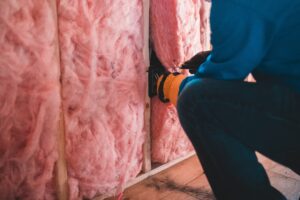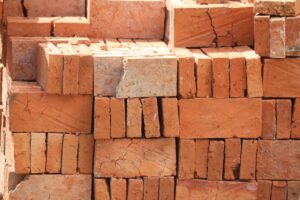Tom Woolley, architect and author, explores the impact that building materials have on indoor air quality and consequently our health.
The past couple of years have made us more aware of health issues than ever before, particularly in relation to our housing.
Many people, forced to spend more time at home, may have wondered whether this is affecting their health. There are obvious mental health problems with being cooped up and it’s even more important to get out for exercise, but how many people think about the higher level of exposure to indoor pollutants and chemicals?
In the past twenty to thirty years, construction of new houses and renovation of existing ones have included much greater use of hazardous chemicals, though awareness of this is not as high as it should be.
Changes to building regulations since the first oil crisis have attempted to make buildings more energy efficient, but this focus has been far too narrow.
The UK construction industry still struggles to understand how to insulate buildings properly and continues to use materials that do not work well and insulations that are bad for health and bad for the planet. Even Michael Gove in Parliament on January 10 referred to what he called ‘dangerous insulations’ and has spoken out against Kingspan (one of the leading insulation companies) sponsoring Formula 1 racing and the Ulster Rugby stadium.
As many more people are facing increases in fuel and electricity costs, there have been calls for houses to be better insulated from industry and activists but neither understand how to do this properly.
In this article, I will try to unpack the many and complex issues about construction materials and building methods and how this has the potential to create serious health problems for both building occupants and the planet.

The performance gap
First of all, there is the problem of the ‘performance gap.’ This was highlighted by the Zero Carbon Hub (ZCH), set up by the UK Government in 2008. The Government abandoned its zero carbon homes policy and shut down the Zero Carbon hub in 2016. However, the real reason for the closure was complaints from the construction industry that their failings to make buildings energy efficient had been exposed.
The ZCH and other important pieces of research showed that many new-build houses failed to achieve the standard of energy efficiency claimed when complying with the building regulations. Often the performance was 70% worse than had been predicted.
The ZCH initially identified this as a problem of poor building practice, but it might have further analysed the failure of standard construction methods and insulation materials.
The focus was on making buildings more air-tight which has led to wrapping most buildings in plastic and sealing them up with non-vapour permeable materials and finishes.
Unintended consequences
This leads us onto the second problem of ‘unintended consequences,’ even new houses have high levels of mould and damp and emit hazardous chemicals which cannot escape.
Even worse has been the so-called retrofit disaster problem, where various schemes, some grant aided, have installed synthetic petrochemical insulation materials into existing houses leading to even more dampness and mould growth.
The aim has been to make houses warmer and it has been claimed in much of the academic and fuel poverty literature that insulating houses leads to better health, even though the evidence for this is shaky at best.
It is possible to carry out quite simple and affordable indoor air quality tests, which identify a wide range of hazardous substances. When the results come back from such a test they are almost certainly going to show high levels of hazardous chemicals including a range of volatile organic compounds, formaldehyde, mould growth and other persistent chemicals which can have serious effects on health, asthma, respiratory conditions and even cancer.
Official Government committees concerned with air quality have their heads in the sand about these issues and are ignoring emissions from building materials. They tend to put the blame for poor air quality on personal hygiene products, cooking odours and paints and decorations as well as outdoor air pollution. While these can contribute to the toxic cocktail of pollutants they are relatively short lived, whereas the real problem remains with persistent and much more toxic substances embedded in the building, which continue to off gas over many years.
Ventilation can partially mitigate this problem. However, while the mechanical ventilation industry pushes for more extract fans and heat recovery systems these do not remove the persistent pollutants like flame retardants, pcbs styrenes, isocyanates substances such as methyl isobutyl ketones, and many more.
How can these problems be avoided?
The Town and Country Planning Association have been campaigning, through a private member’s bill in parliament for Healthy Housing. While this is a welcome initiative, their Healthy Homes Principles do not spell out in detail how houses should be built and are weak on issues such as indoor air pollution. But their proposals at least draw attention to the standard of house construction in the UK.
Houses continue to be built with hazardous petrochemical, flammable insulation materials and the Building Safety Bill, soon to become law, is likely to be seen as one of the worst pieces of legislation in recent years as a panic reaction to the Grenfell tragedy as it will not do enough to make homes safer and healthier.
The bigger picture
Conventional hazardous building materials are not only bad for the health of occupants but their manufacture leads to serious environmental damage on a planetary scale.
Oceans are polluted with plastic waste (not just from single use cups and bags) but construction waste and a range of toxic chemicals such as flame retardants and PFAs.
Production of isocyanates, widely used in modern building materials, has largely ended in Europe because of the toxicity and pollution caused, but the materials are still being produced in China. It was also revealed that CFC blowing agents (banned in 1992) were still being used, leading to serious CFC pollution affecting the ozone layer. Accord Housing Association is attempting to build a nearly plastic free set of houses in Redditch but they are constrained by conventional building practice which makes it hard to exclude plastic altogether.
Alternative healthy, non-toxic materials, which can be used to construct and renovate houses, are widely available but are only used in a small proportion of projects. These products, often made from renewable bio-based materials, can perform much better than conventional construction products. They can insulate better, provide thermal mass to reduce overheating and are mostly breathable so that damp and mould problems are reduced.
They include materials such as sheep wool, wood fibre and hemp. The best non-chemical sheep wool insulation however has to come all the way from Austria even though farmers in the UK get next to nothing for their wool. A wide range of wood fibre products are available but again are imported from France and Germany. At least hemp is produced in the UK but only used in buildings at a cottage industry level. Using natural healthy emission free products could transform house construction and renovation and would only take a few years to scale up to mainstream production, but the petrochemical companies and their lobby groups are very active in resisting this.
A recent report for the York and North Yorkshire Local Enterprise Partnership, by Arup and others sets out very clear figures that conventional house building releases 100 kg of CO2 per square metre, a house built of natural materials has the opposite effect, locking up a similar amount of CO2. Unfortunately, embodied energy is largely ignored by those seeking to create energy efficient buildings.
Even green campaigners, talking of green new deals, Insulate Britain and community energy projects are largely in ignorance of healthier materials. It is particularly difficult to get the mainstream media to take an interest in this topic. ITV has a better record but a recent “Tonight” programme which discussed many of the issues in this article was cut in half to give time to so-called energy experts to bemoan the rise in fuel costs. A further ITV interview with a leading campaigner against retrofit disasters was axed recently as the producer could not see that it was of interest. The BBC doesn’t even bother and only Channel 4 news has kept Grenfell in the public eye.
There is more detailed information on these issues available. My book Building Materials, Health and Indoor Air Quality has sold thousands of copies and I am wading through a mountain of new material to produce Volume 2. Together with Dr. Eshrar Latif at Cardiff University and architect Rachel Bevan we produced a guide to insulation materials for the Institute of Civil Engineering when we realised that such a guide did not exist. Finally, in April a new guide to natural building techniques will be published by Crowood Press.
Photos by Erik Mclean and Mufid Majnun














Nice article Tom! Change is in the air 🙂
We actually made an innovation that uses <microbial friends> to catch & kill pathogens and rebuild the indoor climate, as an add-on to existing ventilation systems.
Here you can find more information; https://www.takeair.world/
Yes it is very informative. Thank you. I hope log burners will be banned in new houses and that heat pumps will become the norm wherever possible or even district central heating. If you make rooms almost airtight to keep out draughts, then there is the risk of damp and mold from high humidity, and the VOC build up as said here. But if you ventilate too much, you might be sucking in polluted air from outside. I believe that is why home owners on the continent, Italy for example, air their rooms for about 15 mins very early in the morning, with bed linen drapped over the balcony or windowsills.Then they close the windows once the stoves are lit and the traffic starts.